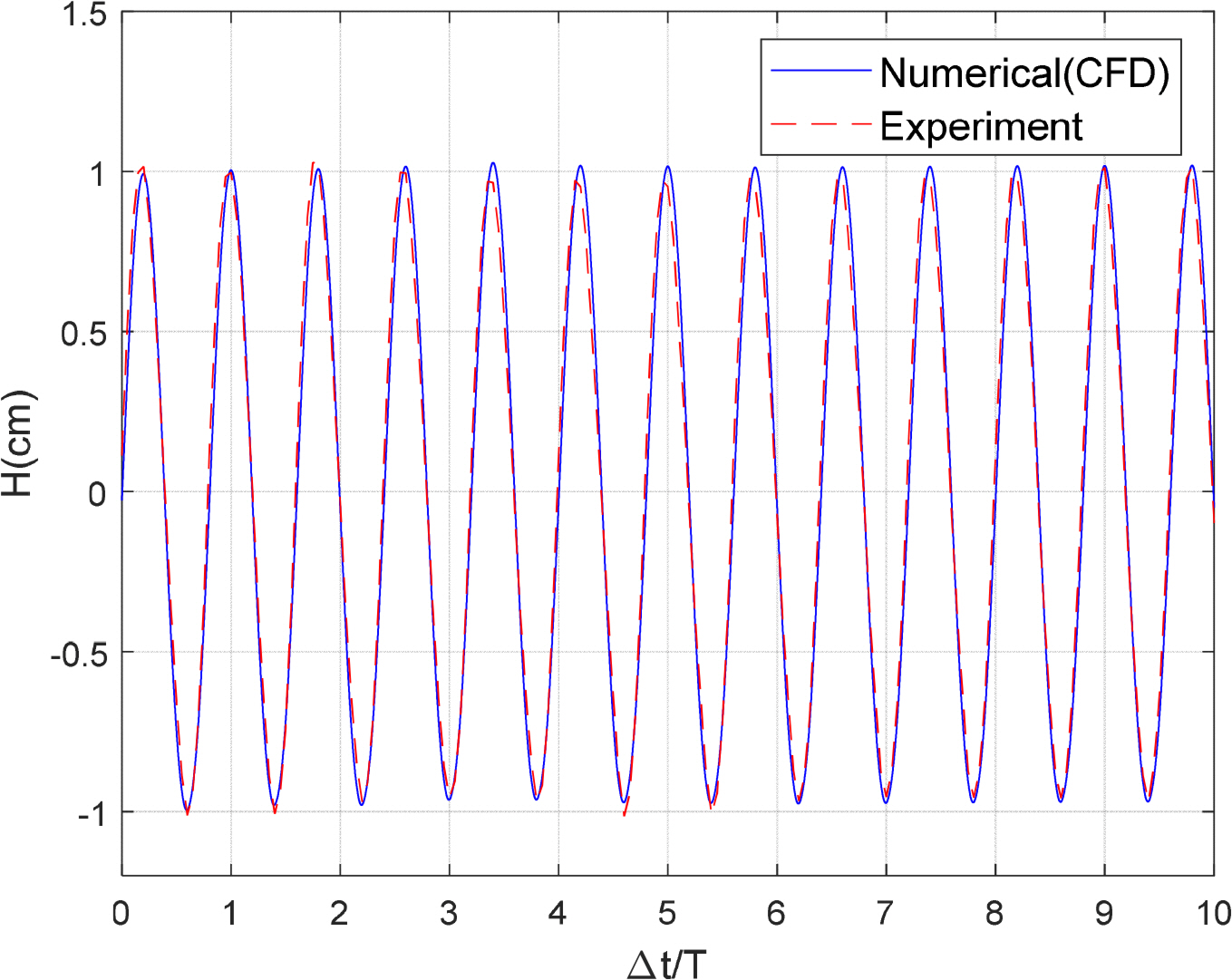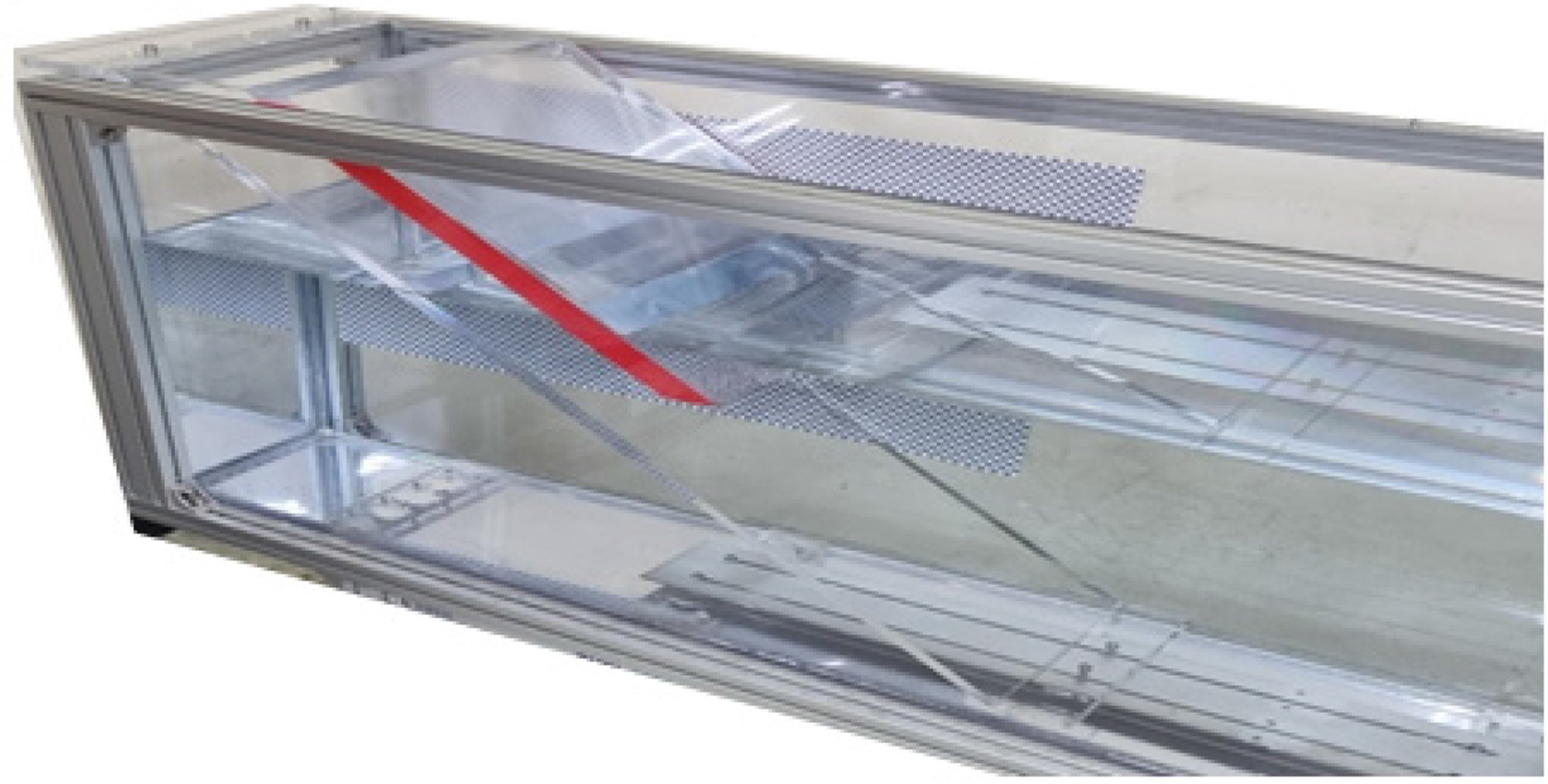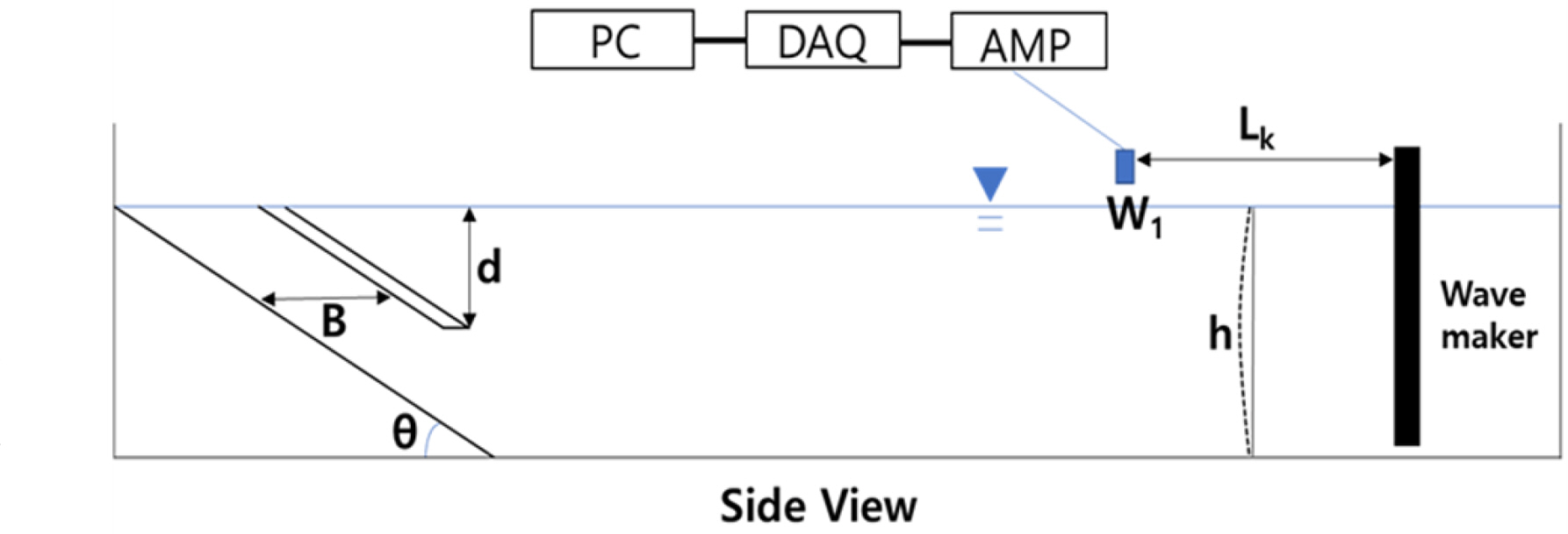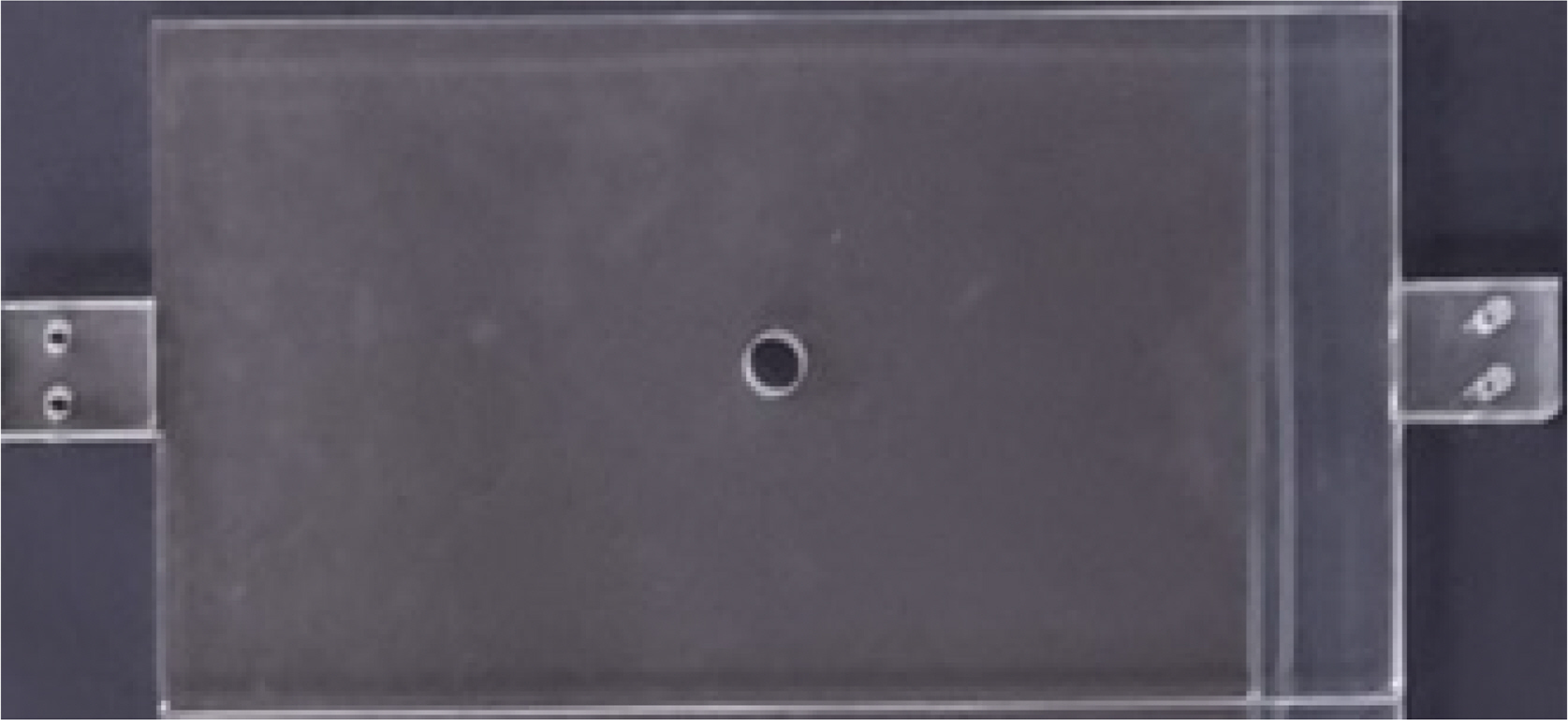4.2 CFD analysis
The real seas applied in the numerical simulation of this study were set as Ganjeolgot Cape near Ulsan, an area with a small tidal range. This location was chosen based on the smooth operating conditions of the breakwater-linked inclined OWC WEC. The experiments and numerical analysis were performed by reducing the water depth, height, and period of the real seas according to FroudeŌĆÖs similarity law. Considering the specifications of the experiment wave tank, the reduction scale was 1/40 compared to that of the real seas.
Table 4 presents the specifications of the 1/40 scale-inclined OWC model used in the numerical analysis and two-dimensional mini wave tank experiment. The depth of the real seas was 12.8 m, and the depth for the 1/40 scale model was 0.32 m. Considering parametric analysis and wave tank specifications, the gap (width) of the OWC chamber was set to 0.06 m, the draft of the skirt to 0.05 m, and the thickness of the skirt to 0.02 m. In addition, the angle between the rear wall of the skirt and tank bottom was set to 33.7┬░, similar to the inclination of a typical bottom-mounded breakwater on the coast of the Korean Peninsula. The length of the numerical wave tank was set the same as the experimental condition with the wave tank.
Table 5 shows the wave conditions for the numerical analysis and experiment of the inclined OWC chamber. Five conditions (cases) were set by increasing the period of the incident wave of the model condition at regular intervals (0.1 s). Previous studies confirmed that the displacement of the water surface inside the OWC chamber is greatly affected by the draft (
d) of the skirt and gap (
B) of the OWC chamber (
Koo et al., 2012).
Table 6 compares the wave elevation inside the OWC chamber for different incident wave cases under the open chamber condition for the pointed- and rounded-skirt conditions.
Hi represents the incident wave height,
Hch the wave height within the OWC chamber, and
RHP and
RHR represent the ratio of the relative wave height in the chamber against the incident wave height under the pointed- and rounded-skirt conditions, respectively. The difference ratio for the two conditions (difference ratio, DR, %) can be represented as (
RHR ŌłÆ
RHP )/
RHP ├Ś100.
For the ratio of relative wave height in the chamber to the incident wave height (RHP and RHR), the maximum values measured at the wave period of 1.1 s (model condition) was approximately 4.6, regardless of the skirt shape. As the incident wave period nears 1.1 s, the water surface displacement in the chamber increases, and the displacement decreases for the incident wave period conditions larger than 1.1 s. In addition, a relative wave height in the rounded-skirt condition was measured larger than the pointed-skirt condition for all incident wave periods, and in Case 2 (wave period of 0.9 s), the DR (%) was approximately 47%. The result indicates that the fluid viscous damping generated when the incident wave enters the chamber is significantly smaller in the rounded-skirt condition than in the pointed-skirt condition. In other words, for the rounded-skirt shape, the incident wave energy consumption caused by the fluid viscous damping can be considered minimized, resulting in more wave energy flowing into the chamber.
In addition, through the DR (%) of the water surface displacement in the chamber, when the incident wave period is smaller than the resonance period (0.8ŌĆō1.0 s), the water surface displacement in the rounded-skirt was at least 36% larger than that in the pointed-skirt condition. However, in a period larger than the resonance period (1.1 s or more), the displacement is relatively small, indicating that, under long-wave period conditions, incident wave energy can easily enter the chamber regardless of the shape of the skirt end, and the effect of viscous damping is relatively small. Therefore, to increase the energy extraction efficiency of the breakwater-linked OWC, designing a skirt shape that minimizes viscous damping under the operating conditions with a wave period smaller than the resonance period is necessary.
Table 7 shows the calculation result of the wave elevation inside the OWC chamber according to the skirt shape with an orifice in the inclined OWC. The orifice functions as an energy conversion device that performs the first conversion of the incident wave energy entering the OWC chamber into pneumatic energy. As the incident wave passes through the skirt and a wave crest is formed in the OWC chamber, the airflow in the OWC chamber is discharged through the orifice (nozzle). The discharged airflow energy is extracted from the incident wave energy in the chamber, and the wave elevation inside the OWC chamber decreases by as much as the extracted energy. In addition, as a wave trough is formed in the OWC chamber, the airflow enters the chamber through the nozzle, and the decrement of the wave elevation inside the OWC chamber is reduced by the incoming airflow energy. Thus, a type of damping acts on the displacement (rise and fall) of the water surface inside the OWC chamber. In addition, the water surface in the orifice chamber is significantly higher in the rounded-skirt condition than in the pointed-skirt condition, indicating that, under the rounded-skirt condition, the amount of residual wave energy in the chamber is considerably large even after subtracting the pneumatic energy extracted by the orifice. Moreover, the generated energy loss owing to fluid viscosity in the skirt corresponds to the difference between the rounded- and pointed-skirt results.
Fig. 8 shows a comparison between the maximum and minimum flow rates inside the OWC chamber with different skirt shapes with an orifice. The wave period was 0.8 s, and the wave height was 0.02 cm. The figure on the left shows the wave elevation, and the figure on the right shows the air flow rate in the orifice. In
Figs. 8(a) and 8(c) the water surface displacement inside the OWC chamber indicates the moment when the elevation rose from the minimum level to the average level; at this time, the force to move upward is the largest, maximizing the air flow rate discharged through the orifice inside the OWC chamber. Conversely, in
Figs. 8(b) and 8(d) the water surface displacement inside the chamber indicates the moment when the elevation is reduced from the maximum level to the average level; at this time, the force to move downward is the largest, and the airflow rate absorbed by the orifice becomes the maximum.
Table 8 shows the comparison of the water surface displacement in the open and orifice chambers with different skirt shapes. As the incident wave period increases, the difference in wave elevation in the orifice chamber increases compared with the open chamber, and the maximum difference is shown at a wave period of 1.1 s, which is the chamber resonance period. In particular, in the pointed-skirt condition, a wave elevation difference of up to 55.4% occurs depending on the presence or absence of an orifice (wave period of 1.1 s). Consequently, this difference in wave elevation is the effect of the pneumatic energy extraction through the orifice and the effect of the additional energy attenuation caused by the orifice condition. In other words, as wave energy is converted into pneumatic energy in the orifice condition, the wave elevation in the chamber is lowered and the difference is extracted as energy; for some of the energy, additional energy attenuation occurs during energy conversion.
Meanwhile, under the rounded-skirt condition, the ratio (DR) of the wave elevation difference between the open and orifice chambers is smaller than that in the pointed-skirt condition. Although a relatively large amount of wave energy flows into the chamber, and the influx of the energy is converted into pneumatic energy, the residual wave energy is also considerably large, resulting in a small wave elevation difference (ratio). In other words, in the rounded-skirt condition, the wave elevation inside the chamber being significantly higher than in the pointed-skirt condition indicates that the residual wave energy remaining after conversion to pneumatic energy is large. If the size of the orifice is optimized, it maximizes the energy extracted and minimizes the wave elevation in the chamber. Moreover, at a wave period of 0.8 s under the rounded-skirt condition, the water surface displacement is larger in the orifice chamber condition than in the open chamber condition, signifying that, under the rounded-skirt condition of a specific wave period, although a large amount of incident wave energy is introduced and some energy is extracted owing to the orifice chamber, a large amount of residual energy remains. However, more detailed analyses such as those involving changes in the pneumatic pressure inside the chamber and particle kinetics are required to identify the exact cause of the result. In conclusion, this study shows that in the rounded-skirt condition, maximizing energy extraction is possible through orifice size optimization while minimizing energy attenuation.

















